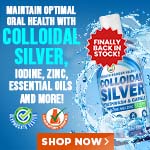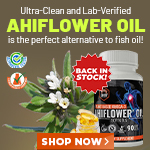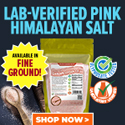
Oil Pulling is a Simple, Inexpensive Method to Improve Your Health
Tuesday, July 21, 2009 by: Maryann Marshall
Tags: oil pulling, health news, Natural News
- China's COVID nightmare returns: Students isolated, deaths hidden as regime doubles down on totalitarian policies
- CDC wants plane travel LOCKDOWN for all humans who haven't received the toxic MEASLES PLANDEMIC VACCINE, even though vaccines don't work
- Forgotten food survival secrets: How ancient preservation techniques can save your family when modern systems fail
- Axis of Evil: CDC and FDA concealed COVID vaccine dangers as injuries soared, new study reveals
- China' rocket fuel DUMP over 7 U.S. states adds to chemical chaos from chemtrails that sicken citizens and fuel sick care industry
- New, weaponized fluoride study ignores BRAIN DAMAGE while pushing forced medication of water
- Parasites, environmental toxins and the silent health crisis sweeping America
- Unlocking nature’s arsenal: The definitive guide to dietary supplements in the fight against cancer
- Much anticipated “MAHA Report” is riddled with AI hallucinations and false citations: MULTIPLE VACCINE ISSUES sidelined in botched White House health initiative
- Massive Saharan dust plume the size of the U.S. barrels toward Florida, triggers health warnings
- Mount Etna erupts in fiery spectacle, forcing tourists to flee as ash plume reaches 4 miles high
- Silent invasion: Oral inflammation's role in systemic disease, from gum disease to heart health
- Trends forecaster Gerald Celente warns of global financial collapse and calls for cultural renaissance
- China-funded group behind New York's $75B climate law sparks national security alarms
- Daily vitamin D may add years to your healthspan by preserving DNA, research reveals
- “Healing Revolution” on BrightU: The silent epidemic fueling chronic illness and the suppression of natural healing
- The Trump-Palantir coup: How the company's stance on privacy for American citizens is under threat
- WAR ON COGNITION: The Coordinated Assault on Your Brain and How to Defend Yourself Against Every Attack
- BEWARE: USDA allows genetically engineered vaccines to infiltrate organic food production
- Amazing microscopy photos reveal how freezing crystals attempt to mimic electronic structures they are touching
- Globalists call for “celebration” of plunging human fertility as war against humanity accelerates
- Biden administration targeted mask and vaccine opponents as "terrorists," new docs reveal
- Holistic eye care and ancient practices challenge surgery’s reign in cataract treatment
- HEALTH SECRETS: How to Instantly Block MSG Toxicity Using Natural Substances (and the secret of Methylene Blue)
- The dark truth behind Ozempic and Wegovy: Big Pharma's profit-driven gamble with your health
- Unlocking methylene blue: A century-old compound steps into the cancer spotlight
- Key to aging gracefully, SUNLIGHT provides vitamin D, boosts nitric oxide, and preserves telomeres
- WAR ON COGNITION: The Coordinated Assault on Your Brain and How to Defend Yourself Against Every Attack
- A closer look at the corporate influences steering the CDC and manipulating US health policy
- Toxicologist reveals four simple ways to slash microplastics in your drinking water
- MSG EXPOSED: Hidden Neurotoxins Found in Groceries, Snacks and Popular Fast Food Menus
- LYME DISEASE on the RISE raising suspicion it's still part of U.S. military bioweapons program gaining traction for Lyme Disease PLANDEMIC
- Is Del Bigtree leaving MAHA? Bigtree blasts the MAHA report's shocking silence on vaccine failure and vaccine injury
- Study: Methylene blue and near-infrared light show promise in preventing brain degradation
- Breaking the aging code: How diet shapes longevity from breakfast onward
- Facebook/Instagram restore old censorship regime following shooting of two Israeli embassy aides
- Big Pharma's Dirty Secret: How Prescription Drugs Are Starving Your Body of Essential Nutrients
- WAR ON COGNITION: The Coordinated Assault on Your Brain and How to Defend Yourself Against Every Attack
- RED ALERT: Nuclear War Between India and Pakistan Could Trigger Global Catastrophe… full RISK ANALYSIS
- Singapore's draconian vaccine mandate: Citizens face jail time for refusing FORCED medical procedures that do HARM
- MSG EXPOSED: Hidden Neurotoxins Found in Groceries, Snacks and Popular Fast Food Menus
- HEALTH SECRETS: How to Instantly Block MSG Toxicity Using Natural Substances (and the secret of Methylene Blue)
- JESUS NEVER SPOKE ENGLISH: Historical facts on why the Bible you’re probably reading has been altered, redacted or hidden from much of its original meaning
- Globalists call for “celebration” of plunging human fertility as war against humanity accelerates
- Why All Government Officials and Big Tech CEOs Who Engage in Systematic Viewpoint Censorship Must Be ARRESTED, Prosecuted, and Sentenced to Life in Prison
- Landmark study of 85 million reveals shocking surge in heart attacks, strokes, and sudden death following the notorious COVID-19 jab
- BEWARE: USDA allows genetically engineered vaccines to infiltrate organic food production
- Silent catastrophe: COVID-19 vaccines linked to plummeting fertility rates, Czech data reveals
- Doctors are still puzzled about “long vax,” a set of symptoms linked to COVID-19 vaccines
- Head of L.A. Port warns of incoming plunge in U.S. supply chain, empty shelves and inventory depletion in 5-7 weeks
- WHO Pandemic Treaty sparks sovereignty concerns amid secretive voting and U.S. withdrawal
- Canada's COVID cover-up: Health officials swore secrecy to protect Trudeau from vaccine scandal
- Brushing with poison: Study finds toxic heavy metals in 90% of toothpaste brands, including those for children
- Texas governor threatens San Marcos over pro-ceasefire resolution, igniting free speech debate
- Red Cross issues warning to stop blood plasma donations from vaccinated people
- Scientists confirm: GENIUS brain function can be spontaneously unleashed in humans without any apparent cause
- EPA advisor admits the agency is funneling billions to climate groups ahead of Trump’s return to White House
- HYSSOP: What research reveals about the health benefits of this ancient holy herb
- Two containers with completed ballots fall out of truck in Florida
- Newly released JFK files reveal Pentagon's role in creating Lyme disease and covid in the same lab
- Mike Adams releases country western hit single: Goin’ Back in Time is Comin’ Home
- Global leaders unite to clamp down on “misinformation” with UN-backed Cascais Declaration
- BREAKING: 2025 NDAA authorizes mandatory military draft of WOMEN across America… as Pentagon pursues global NUCLEAR war with both Russia and China at the same time
- I Want My Bailout Money – new song released by Mike Adams
- Michael Yon warns of a ZIONIST TAKEOVER in Trump’s second administration
- BOMBSHELL: DNA testing kits are a SCAM to develop ethnic-specific bioweapons
- Ozempic and Wegovy weight loss drugs are injectable LIZARD VENOM PEPTIDES that may unleash a devastating wave of organ failure… side effects align with symptoms of SNAKE BITES
- The Health Ranger releases “Vaccine Zombie” song and music video, using AI-animated zombies for the music video
- These 13 countries just signed an agreement to engineer a global FAMINE by destroying food supply
- Israeli soldiers accused of even more torture and abuse in the West Bank
- RFK Jr. clears key hurdle: Sen. Susan Collins backs controversial HHS nominee, signaling a new era for health policy
- Sermon 30: How Jesus reveals Caesar’s FAKE CURRENCY and FALSE AUTHORITY
Toxic substances stimulate the immune system to go into action. These substances can range from foreign chemicals to bacteria, viruses, fungi, or parasites.
The immune system`s response to toxins generates free radicals which create inflammation throughout the body. A healthy body can clear this inflammation in a short period of time. However, our day to day food, lifestyle, and environmental milieu hammers on our bodies. These assaults erode the efficiency of the body`s anti-inflammatory mechanisms. Thus, inflammation builds up in various parts of the body leading to a degeneration of health and vigor.
Throughout the history of natural medicine, cleansing has been a mainstay - or at least beginning - for optimizing health. A variety of techniques have been used, for instance:
* Fasting.
* Modified fasting using fruit and vegetable juices.
* Eating raw foods.
* Following a mucus-less diet.
* Supporting the blood and liver in their cleansing activities.
* Using herbs, plant fiber, or salt water to purge the colon.
* Colonics.
* Enemas.
* Charcoal.
* Stimulating the kidneys.
* Sitting in a room or shelter which encourages profuse sweating.
* Application of hot and/or cold water baths.
From the Aruvedic tradition of India comes yet another tool to add to this arsenal: oil pulling. It is mentioned in the ancient Ayurvedic text, Charaka Samhita, where it is called Kavala Gandoosha or Kavala Graha. It has been brought to the attention of modern practitioners by a Dr. F. Karach. He presented oil pulling in a paper before a meeting of oncologists and bacteriologists belonging to the Academy of Science of the USSR.
Oil pulling is a traditional Indian folk remedy for strengthening teeth, gums, and jaws. It helps to prevent tooth decay, bad breath, bleeding gums, dryness of the throat, and cracked lips. It is also used to reduce enamel wear from stomach acid in hangovers and bulimics.
Other systems of the body benefit from oil pulling as well. Dr. Karach lists these examples of ailments which are alleviated by oil pulling:
* head-aches.
* bronchitis.
* tooth pain.
* thrombosis.
* eczema.
* ulcers.
* diseases of stomach, intestines, heart, blood, kidney, liver, and lungs.
* women`s diseases.
* diseases of nerves.
* paralysis.
* encephalitis.
* prevents the growth of malignant tumors, cuts and heals them.
* chronic sleeplessness.
The procedure is simple, inexpensive, and uses readily available ingredients. First thing in the morning (and before meals, on an empty stomach), oil is swished around in the mouth for 15 to 20 minutes, then spit out. That is all there is to it. No fancy equipment or complicated techniques are required.
Cold pressed sesame oil is regarded as the best oil for this use. Sunflower oil also comes highly recommended. If these are not available, you may try refined oils or another pure vegetable oil that does not have genetically modified sources. However, oils other than sesame or sunflower have not been shown to be as effective.
Sesame oil is derived from the plant Sesamum indicum of the Pedaliaceae family. The seeds of the plant are known as benne, `gingelly` or `teel`. It is often used for cooking and as a flavor enhancer in Indian, Chinese, Korean, and to a lesser extent Southeast Asian cuisine. Due to the natural antioxidants present in the oil, it is least prone among cooking oils with high smoke points (its average smoke point is 420 degrees F) to turn rancid when kept at room temperature. Still refrigeration is recommended for optimum freshness.
Sesame, one of the first crops processed for oil, is considered the queen of the oil seed crops because of its nutritional qualities and many desirable health effects. Few people have allergic reactions to sesame. If you have a mild allergic reaction, try a different brand of oil, as manufacturing practices vary from one to another.
Sesame oil has a high concentration (41 percent) of polyunsaturated fatty acids. It is a good source of vitamin E. Among six edible plant oils tested, sesame oil had the highest antioxidant content. The antioxidants present in it are mainly sesamol, sesamin, and sesamolin. Sesamin has been found to inhibit the absorption of cholesterol as well as limiting cholesterol production in the liver. It reduces the formation of fat cells and acts to lower blood pressure. Sesame oil is said to generally fortify the constitution during recuperation from severe or prolonged illness.
As with most plant based condiments, sesame oil contains magnesium, copper, calcium, iron, zinc and vitamin B6. Copper provides support for the nerves which regulate heart beat and provides relief for rheumatoid arthritis. Magnesium supports muscle, blood vessel, and respiratory health. Calcium helps prevent colon cancer, osteoporosis, migraine and PMS. Zinc promotes bone health.
Sesame seed oil helps joints keep their flexibility.
Keeping the skin supple and soft, sesame oil has multiple uses in skin care. It heals and protects areas of mild scrapes, cuts and abrasions. It helps tighten facial skin, particularly around the nose, controlling the usual enlargement of pores as skin ages chronologically.
In The Green Pharmacy, the prominent herbalist James Duke states that sesame contains at least seven pain-relieving compounds. Thus, sesame may also have some power as an analgesic.
In lab cultures, sesame seed oil inhibited the growth of malignant melanoma - a skin cancer - (Prostaglandin Leukatrines and Essential Fatty Acids 46: 145-150, 1992) and replication of human colon cancer cells (Anti Cancer Research 11: 209-216, 1992).
Two scientific studies indicate the effect of oil pulling against specific bacteria in the mouth cavity. Streptococcus mutans, which reportedly causes dental caries, was measured. Subjects swished sesame oil in their mouths for ten minutes a day. Within a week, bacterial counts in the mouth were significantly lowered.
The mouth contains many blood vessels quite close to the surface. When food is thoroughly chewed, it mixes with saliva which contains a large number of enzymes. Many nutrients are absorbed through the buccal tissue (tissues inside the mouth) before food descends to the stomach. In fact, with enough chewing, forty percent of carbohydrate digestion takes place in the mouth. Thus, the beneficial effects of the sesame oil can be transmitted to the body, without swallowing it. While some controversy exists about whether molecules can be passed through these membranes into the mouth, there is a sense in which oil pulling may remove toxins from the body.
Oil, which is composed of fat molecules, is a medium which is very absorbent. The fat in your body stores certain vitamins, excess hormones, and many toxic chemicals.
Sesame oil is reputed to penetrate the skin easily, and is used in India for oil massage. Sesame seed oil absorbs quickly and penetrates through the tissues to the very marrow of the bone. It enters into the blood stream through the capillaries and circulates. The liver does not sweep sesame seed oil molecules from the blood, accepting those molecules as friendly. Oil soluble toxins are attracted to sesame seed oil molecules which can then be washed away. These same properties may take place in the buccal tissues during oil pulling.
Here is the oil pulling procedure, step by step:
Step 1: First thing in the morning, on an empty stomach, and before drinking any liquids (including water), pour exactly one tablespoon of sesame or sunflower oil into your mouth. Use one teaspoon for children old enough to be able to swish it without swallowing it - most sources suggest an age of five. If you wear dentures, oil pulling is done with the dentures out of your mouth. Some people choose to accelerate oil pulling`s effects by swishing two or three times a day. It should be done before meals or several hours after a meal, on an empty stomach.
Step 2: Swish the oil around in your mouth without swallowing it for about twenty minutes. Move it around in your mouth and through your teeth. Sip and suck it through the teeth. Use a gentle chewing motion from time to time. Don`t tilt your head back to gargle. Keep swishing. If your cheek or jaw muscles get sore while swishing, you are putting too much effort into it. Relax your jaw muscles and use your tongue to help move the liquid around the inside of your mouth. When you do this correctly, you will feel very comfortable. Pretty soon, it will become second nature. You will find that the oil starts to get watery in the first ten minutes, as your saliva mixes with it.
Step 3: As the end of the oil pulling session approaches, the oil/saliva mixture in your mouth becomes thicker. This is quite normal, since it is pulling out toxins from your body. When 20 minutes are up, spit out the oil into the commode. It is best if you do not spit into the sink. Do not be alarmed if it looks yellow or whitish - this also is normal.
Step 4: Rinse out your mouth a couple of times with warm water or with a good mouthwash and spit into the commode. One method is to rinse and spit with regular hydrogen peroxide diluted half and half with water (or use full strength). Once again, do not swallow. The hydrogen peroxide is very effective in rinsing out any toxins or organisms which may be left in the mouth.
Step5: Brush your teeth. Use a damp toothbrush with a small amount of baking soda. A small amount goes a long way and minimizes the abrasive effect of the baking soda. The baking soda will normalize the pH of the mouth.
Sesame oil has the following advantages over the standard and commercially available mouthwashes: it causes no staining, has no lingering aftertaste, and causes no allergic reactions. It is five to six times more cost-effective than the commercially available mouthwashes and is, moreover, readily available in the household.
For more information:
http://www.oilpulling.com
http://www.ijdr.in/text.asp?2008/19/2/169/40...
http://www.jisppd.com/article.asp?issn=0970-...
http://iadr.confex.com/iadr/2008Toronto/tech...
http://www.answers.com/topic/sesame-oil
http://www.youthingstrategies.com/qualities....
http://findarticles.com/p/articles/mi_g2603/...
About the author
Maryann Marshall is a fourth generation herbalist. She taught "Herbs and Your Health" classes for 25 years. Currently she is developing these classes into an online course. See http://www.grainsofhope.com for more information.Eight years ago, her eldest son suffered a severe brain injury in an auto accident. His journey to wellness continues today. The family struggles through the government and medical labyrinth to assist his healing through prayer, nutrition, herbs, and other natural methods. Maryann is currently writing a book about the accident and its aftermath. You can read it in progress at: http://MiracleBoyArif.blogspot.com/ .
Her websites can be found at: http://www.agglom.com/agglom/36788/Maryann_M.... Also check http://www.mymoxxor.com/grainsofhope for the most powerful concentrate of all-natural omega-3's and antioxidants on the planet and http://www.youngliving.com/grainsofhope for therapeutic grade essential oils.
Oil pulling at FETCH.news
Get independent news alerts on natural cures, food lab tests, cannabis medicine, science, robotics, drones, privacy and more.
Take Action: Support Natural News by linking to this article from your website
Permalink to this article:
Embed article link: (copy HTML code below):
Reprinting this article:
Non-commercial use OK, cite NaturalNews.com with clickable link.
Follow Natural News on Facebook, Twitter, Google Plus, and Pinterest
Science News & Studies
Medicine News and Information
Food News & Studies
Health News & Studies
Herbs News & Information
Pollution News & Studies
Cancer News & Studies
Climate News & Studies
Survival News & Information
Gear News & Information
News covering technology, stocks, hackers, and more



"Big Tech and mainstream media are constantly trying to silence the independent voices that dare to bring you the truth about toxic food ingredients, dangerous medications and the failed, fraudulent science of the profit-driven medical establishment.
Email is one of the best ways to make sure you stay informed, without the censorship of the tech giants (Google, Apple, Facebook, Twitter, YouTube, etc.). Stay informed and you'll even likely learn information that may help save your own life."
–The Health Ranger, Mike Adams












































